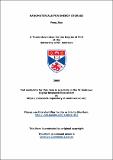Files in this item
Nanomaterials for energy storage
Item metadata
| dc.contributor.advisor | Bruce, Peter G. | |
| dc.contributor.author | Jiao, Feng | |
| dc.coverage.spatial | 134 | en |
| dc.date.accessioned | 2008-05-16T15:53:16Z | |
| dc.date.available | 2008-05-16T15:53:16Z | |
| dc.date.issued | 2008-01-01 | |
| dc.identifier | uk.bl.ethos.552066 | |
| dc.identifier.uri | https://hdl.handle.net/10023/487 | |
| dc.description.abstract | The results presented in this thesis demonstrate the first synthesis of several nanostructured transition metal oxides and lithium containing transition metal oxides. Their uses in lithium-ion batteries and/or as magnetic materials have been investigated. The first example of two and three dimensional mesoporous Fe₂O₃ has been prepared by using the soft templating (surfactant) method. The materials have amorphous walls and exhibit superparamagnetic behaviour. By using a hard template route, a mesoporous α-Fe₂O₃ with highly crystalline walls has been synthesized. Its unique magnetic behaviour, distinct from bulk α-Fe₂O₃, nanoparticulate α-Fe₂O₃, and mesoporous Fe₂O₃ with disordered walls, has been demonstrated. The hard template method was also used to prepare nanowire and mesoporous Co₃O₄, β-MnO₂ and MnO₃ with crystalline walls. Their electrochemical properties as electrodes in Li-ion batteries have been investigated. Mesoporous β-MnO₂ can accommodate 0.9 Li/Mn in stark contrast to bulk β-MnO₂ which cannot accommodate Li. To prepare mesoporous materials which cannot be obtained directly by the hard template method, a post-templating route has been developed. Mesoporous Fe₃O₄, γ-Fe₂O₃, and Mn3O4 with ordered mesostructures and highly crystalline walls have been obtained by post-synthesis reduction/oxidation treatments. All the materials show unique magnetic properties compared with nanoparticulate and bulk materials. Also, the first example of lithium containing mesoporous material, LT-LiCoO₂, was synthesized by first preparing mesoporous Co₃O₄, then reacting this with LiOH to form LT-LiCoO₂, with retention of the ordered nanostructure. The nanostructured LT-LiCoO₂ compounds demonstrate superior performance compared with normal or nanoparticulate LT-LiCoO₂, when used as intercalation electrodes in lithium batteries. Finally, monodispersed Mn₃O₄ nanoparticles (diameter ~ 8 nm) with a core-shell structure (a highly crystalline Mn₃O₄ core encased in a thin MnO₂ shell) have been prepared for the first time. Ordered three-dimensional arrays form by spontaneous self-assembly. Magnetic measurements demonstrated that the self-assembled three-dimensional arrays exhibit spin-glass behaviour, rather than the anticipated superparamagnetic behaviour for isolated nanoparticles. Such behaviour is interpreted as arising from strong interactions between the core (crystallized Mn₃O₄) and shell (MnO₂). | en |
| dc.format.extent | 7924891 bytes | |
| dc.format.mimetype | application/pdf | |
| dc.language.iso | en | en |
| dc.publisher | University of St Andrews | |
| dc.subject | Lithium batteries | en |
| dc.subject | Mesoporous | en |
| dc.subject.lcc | TA418.9N35J5 | |
| dc.subject.lcsh | Nanostructured materials--Synthesis | en |
| dc.subject.lcsh | Lithium cells | en |
| dc.title | Nanomaterials for energy storage | en |
| dc.type | Thesis | en |
| dc.type.qualificationlevel | Doctoral | en |
| dc.type.qualificationname | PhD Doctor of Philosophy | en |
| dc.publisher.institution | The University of St Andrews | en |
This item appears in the following Collection(s)
Items in the St Andrews Research Repository are protected by copyright, with all rights reserved, unless otherwise indicated.

